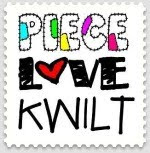I do my applique by hand using the needle turn technique. I’ve not really done fusible machine applique, but understand the general principles IE: unless you are doing needle turn, your set up/prep/all that good stuff will be completely different and the tutorials will probably be useless to ya......but hey, maybe, just may-be, you'll be motivated to at least try needleturn (try it you might like it).....i know it's the 'A' word in some circles....but wouldn't it be nice to carry your finished HAND applique quilt to your guild's meeting and beam proudly while saying, "i did the applique by hand" i guarentee you'll get a couple "Owwws" and "Ahhs".....unless your guild is a hand applique guild....then be different and do it by machine *giggle*
anywhoooo- moving on....
Cutting:
From the background fabric cut one 33” square. We will trim this down later and i'll tell you the size then.... Applique tends to ‘shrink’ the background, so we aren’t cutting it to size yet.
I used scraps and stash for my pieces. I do recommend using nothing smaller than fat quarters for the bias stems. I cut my bias strips from across the widest part of each fat quarter (corner to opposite corner). You’ll only need one from each fat quarter or you can cut all four from the same fat quarter- it’s your quilt! I used four different fabrics for each curved long stem, and one fabric for the straight stem of the large flower.
Prep:
Fold your background fabric horizontally in half and press.
Open back up and press it in half vertically, matching the ends of the previously pressed line on the edge. Make sure you don’t lose the first pressing line when ironing the second.
Open up fabric and mark an ‘+’ where the two lines meet. I suggest that you test your marking utensil on an edge or scrap piece to guarantee that the lines remove by your chosen way to your satisfaction.
(i'm going to share a story: i only use chalk pencils now. i used a water soluble pen (the blue one) to mark quilting lines (back when i was hand quilting everything) and when i got done and washed the quilt to remove the lines- where all the marks were bleached out. noticeably bleached out...just saying...)
Measure out each pressed line 15” and make a tick mark. (this is where it’s handy to have that big 21” square ruler).
Connect the tick marks to give yourself a 30” drawn square on your fabric. This is the perimeters of the block and no fabric should cross it. To ‘set’ the chalk lines, a light spritz of sizing/starch will keep the lines from disappearing, but will allow them to wash/wear off later down the road.
Mark the quarters of the block (15”) then mark the diagonals. Then mark the diagonal of the 1/4 blocks. Your background should look like this.
Mark the diagonal of each ¼ of the background using the horizontal and vertical center lines we pressed earlier.
Your background fabric should now look like this with the same corresponding lines.
Take the ¼ block drawing and using a light box lay the background fabric on it, lining up all registration marks. Your lines will be difficult to see on the fabric, take your time, the results will be worth it.
A light box can be made from a glass top table simply be placing a lamp under it. If you have a wood table, pull apart the leaves and place a piece of Plexiglas across and put a lamp underneath…a large window and tape works too…
Using the 1/4 block drawing and the lightbox, mark the curves for the bias stems.
*see photo below before marking stems*
this picture is after i marked using the lightbox, the lines totally don't show when photoed on the lightbox....
Don’t draw the lines where the stems go under each other. This will allow you to easily place them and this will let you ‘weave’ them later. the ‘broken’ line goes under the stem that isn’t. geez, does that make sense?
Collect your bias stems, pins, and elmers stick glue. The glue stick is water soluble, non-toxic, acid free, and photo safe. It’s inexpensive and readily available. (ie- i got it at walmart)
I used two clover bias tape makers.
The curved stems are 3/8” wide, cut at 7/8”….i used the clover maker # 9.
The straight stems for the larger flower are ½” wide, cut at 1” using the clover maker #12. I use bias for the straight stem for durability on the raised edges.
Using the pins and glue, place the bias stems, weaving them under and over each other. Refer to the drawing of the ¼ block and full block diagram if needed for placement.
i also placed the straight stems also. the big flower's leaves fit under them...hide/tuck the raw edge of that stem under where the curved stems cross. refer back to this picture, or the 1/4 block drawing from the pattern pdf.
After I have all the stems placed and securely glued, I run a basting stitch through the center of all stems. This is because we have pieces (the leaves) that go under them and they will be used to place those pieces and the glue won’t hold them through the applying of all those pieces. I only use glue to temporary hold what I can applique at that time.
now you're ready to start appliqueing the whole block. here's the order:
- (see the leaf tutorial here) applique all leaves. the reason we placed our stems first is to make placing the leaves easier. it's like building a house, the stems are the foundation we build the rest of the walls on.
- applique the edges of all the stems. remove the basting stitches as you go.
- the 4 large corner flowers in this order- (referring to the assigned letter of the pieces from the pdf pattern found here) D-B-A-C
- then the 8 smaller flowers in this order: (referring to the assigned letters from the pdf pattern) H-F-E-G


































No comments:
Post a Comment
thanks so much for taking the time to comment, they feed my blog. i do my best to reply to each and every one! you can bet your comments are ALWAYS read and appreciated.